Northeastern Orchids
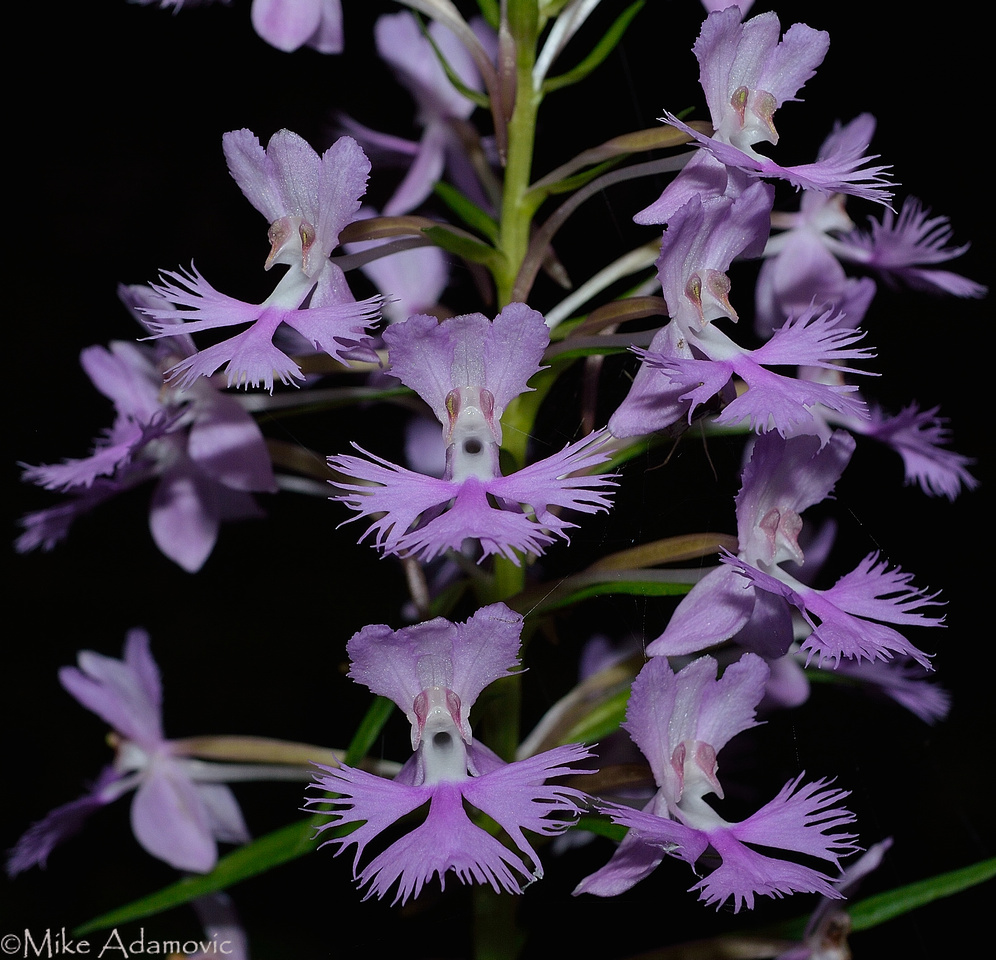

When it comes to plants and botany, the average person normally has difficulty in rousing more than a cursory interest. Compared to wildlife, our leafy cousins are hard to relate to. They don’t breathe or eat in the same sense as you and I, you can’t pet or train them, and they don’t move. A pine or maple certainly won’t be showing off aerial acrobatics like a shifty bat or majestic eagle. And even the most beautiful spring ephemerals—the ivory petaled bloodroot whose large, showy blossoms herald the end of winter—red trillium with its deep maroon petals and hypnotizing multiples of three—or the dainty bluets whose azure tints emulate the sky—can’t dish out a shot of adrenaline on par with a bear or rattlesnake encounter. As a botanist, it’s often disheartening to find this unique group of organisms neglected and not given their due. While it’s undoubtedly true they lack many electrifying attributes, they are far from dull.
When I talk to people about a unique shrub, a threatened species of milkweed, or the intricate network of underground mycorrhizal fungi that connect many plants in a similar vein to our internet, I receive either a suppressed chuckle or the half-hearted “Mhmm… that’s interesting” response. In such cases, I feel myself slowly slipping into esoteric obscurity. But when I bring up the topic of orchids, things drastically change. Even those who don’t garden or enjoy a walk in the woods find them charming. Orchids have a reputation of being exotic and refined, standing as a class of their own and being rather discriminating.
Most orchids are indeed finicky plants that, true to their reputation, only grace an area with their presence if all of their conditions are met absolutely perfectly.
We find common ground with orchids. And for that I am grateful. For while I try to love all groups of plants equally, my heart, like most people, has an especial fondness for these exquisitely beautiful primma donnas.
Orchids are tailored for a unique (and narrow) set of environmental conditions and, many times, pollinators. If the pH or light conditions are slightly off, an orchid will not grow. Some have evolved to be pollinated by very specific insects. Prairie fringed and roundleaved orchids are pollinated almost exclusively by long-tongued hawk moths. If these creatures are absent, or dwindle for some reason, the orchids in question will not be found in a particular area. But most importantly, the dust-like seeds of orchids lack endosperm, a material that nourishes a fledging plant (think of a meaty acorn). Lacking sustenance, they must obtain it via fungi. Many orchids have formed a mutualistic association with fungi from a particular genus or even a single species. If the right fungi are absent, no orchids. So, everything needs to fall into place perfectly for an orchid to survive and thrive—even the smallest problems could have disastrous consequences. For this reason, orchids are bioindicators of habitat health and vigor.
While individual orchid species are confined to strict habitat types, as a group, they occur over a vast area, from sunny bogs and wetlands to open fields and twilight forests.
Bogs are one of the best places to search for these magical plants. Vivid roseate and magenta hues of the rose pogonia, grass-pink, and dragon’s mouth stand out amid quaking lime-green peat mats like torches. Ghostly white-fringed orchids also make an appearance during the decline of summer.
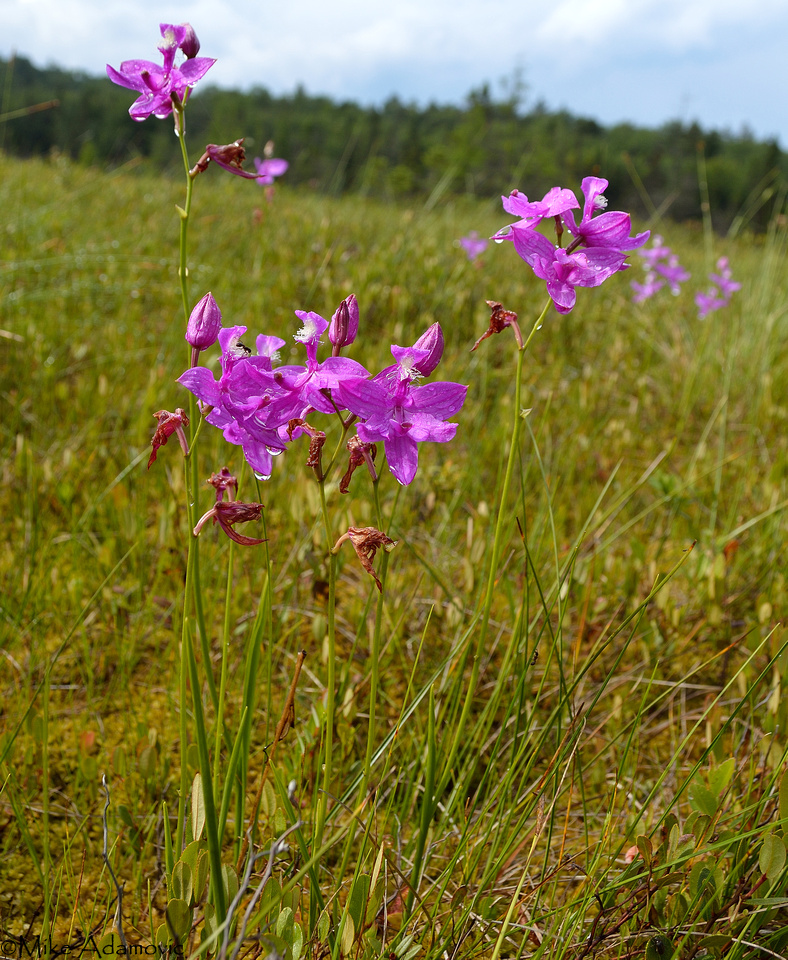

Grass-pink (Calopogon tuberosus)


Rose pogonia (Pogonia ophioglossoides)
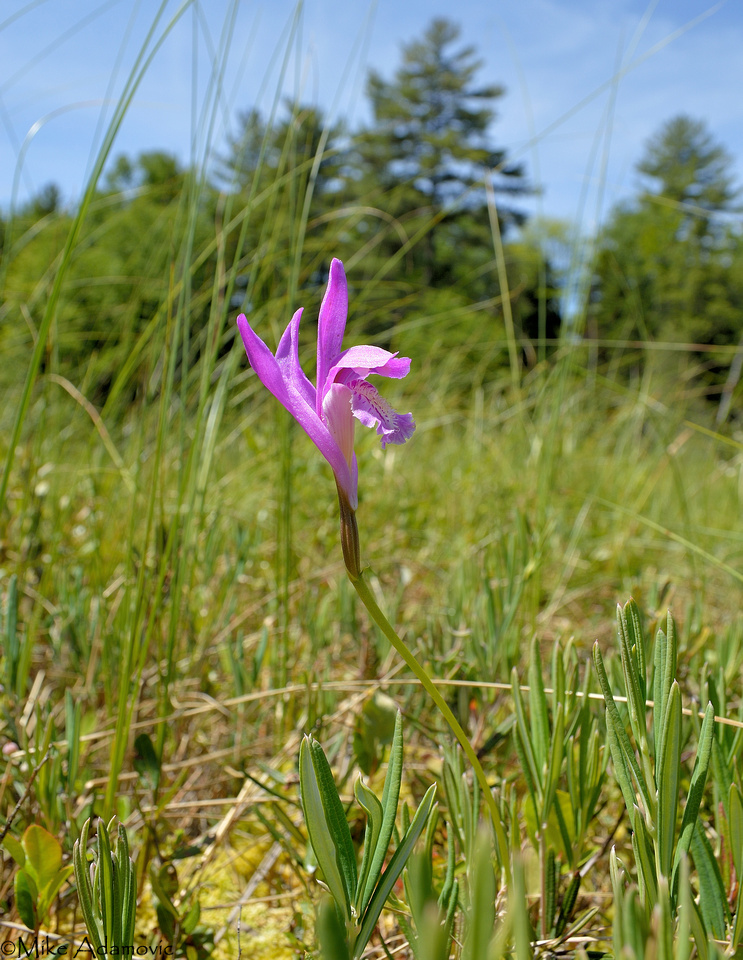

Dragon's mouth orchid (Arethusa bulbosa)
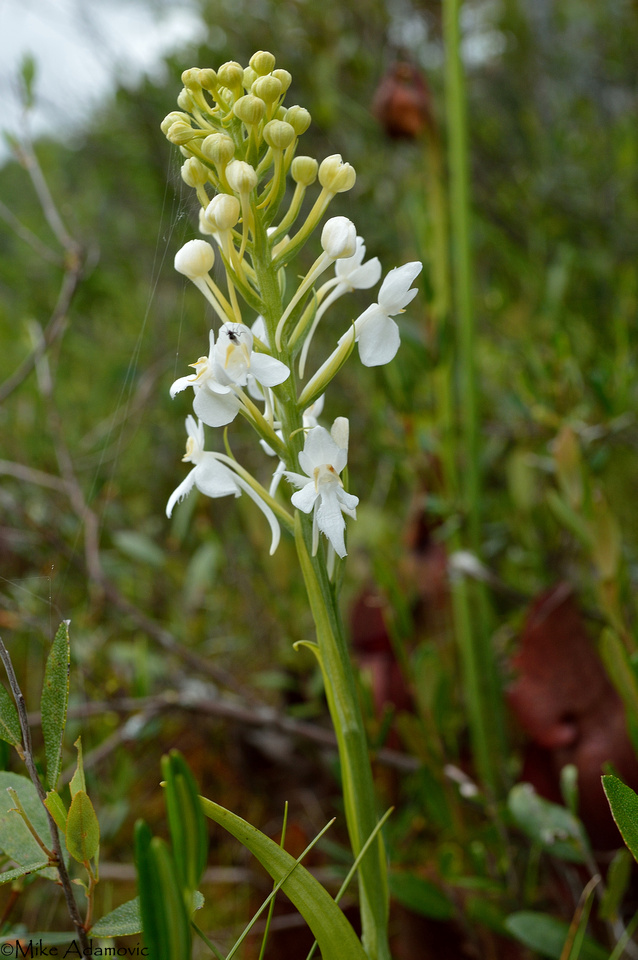

White fringed orchid (Platanthera blephariglottis)
Fens, the neutral to alkaline cousin of the acidic bogs, are home to showy lady’s slipper, ladies’-tresses, and bog candles.
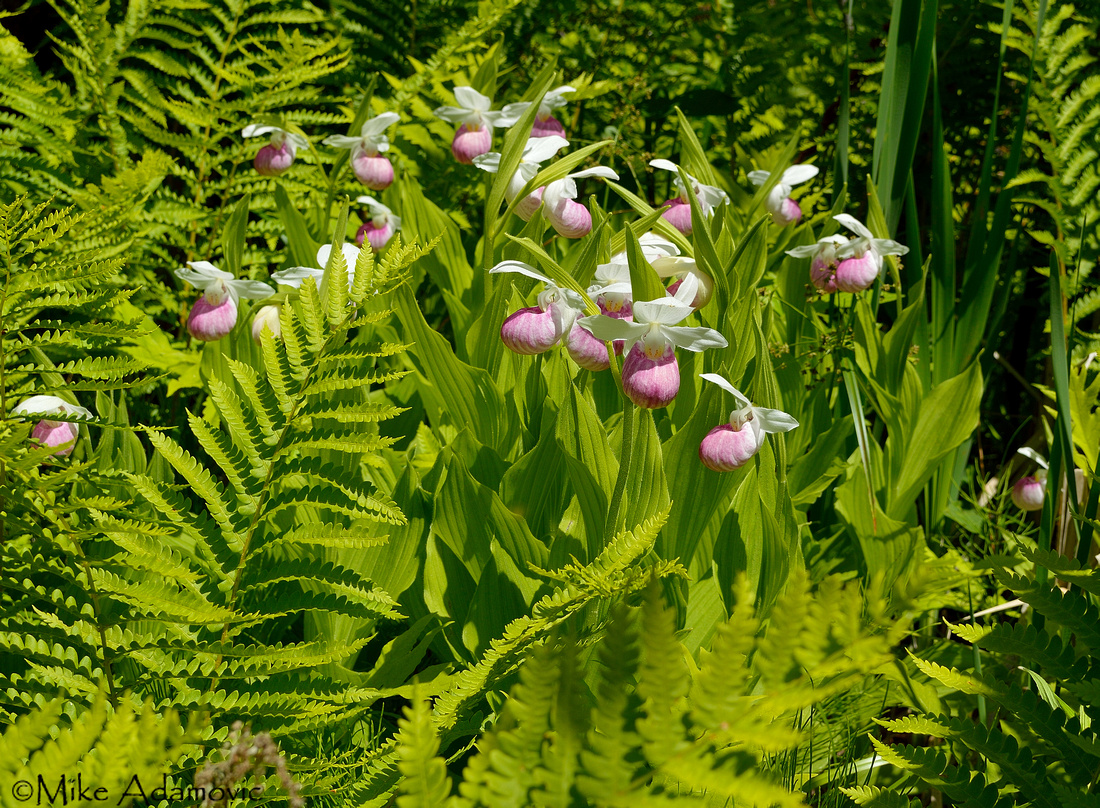

Showy lady's slipper (Cypripedium reginae)


Shining ladies'-tresses (Spiranthes lucida)
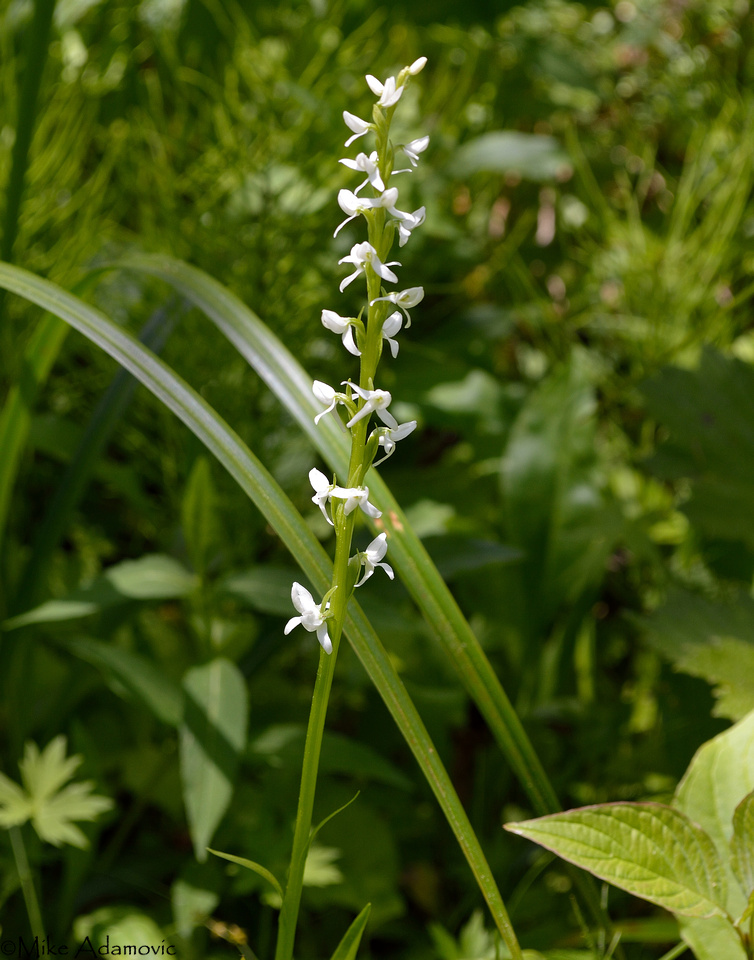

Bog candle (Platanthera dilatata)
Moist fields are home to ladies’-tresses and the ragged fringed orchid.
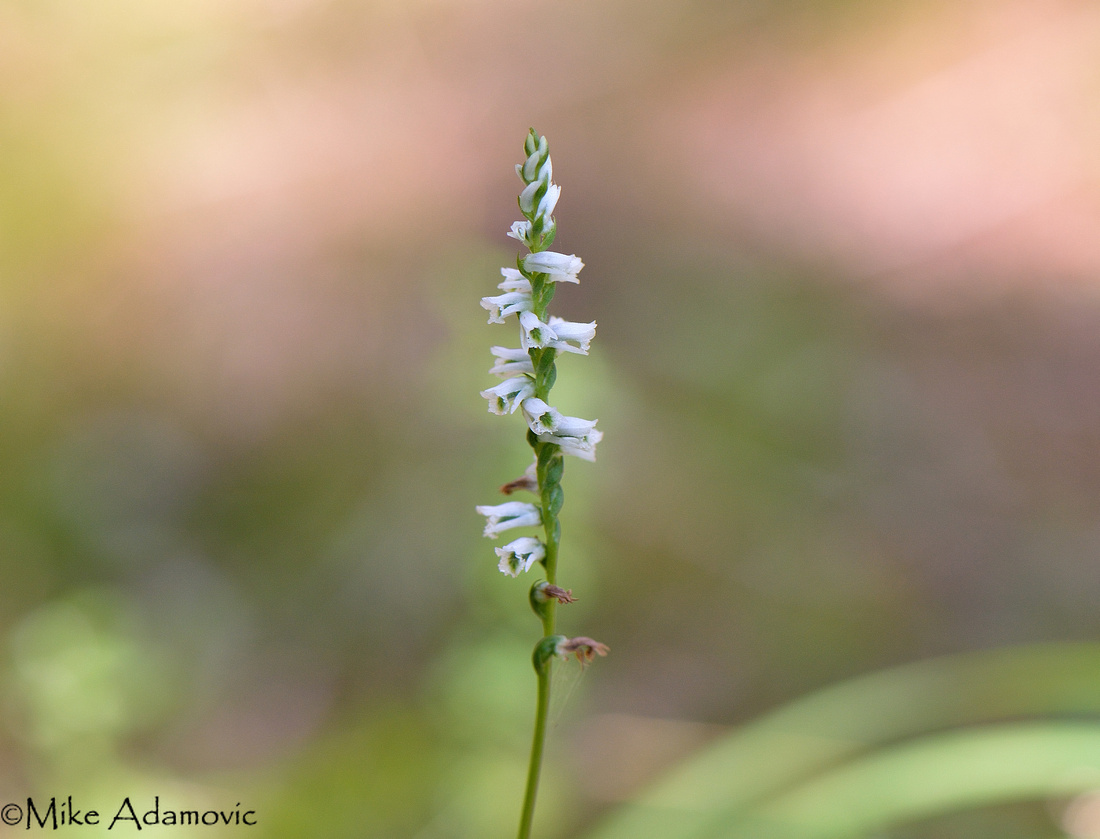

Southern slender ladies'-tresses (Spiranthes lacera)
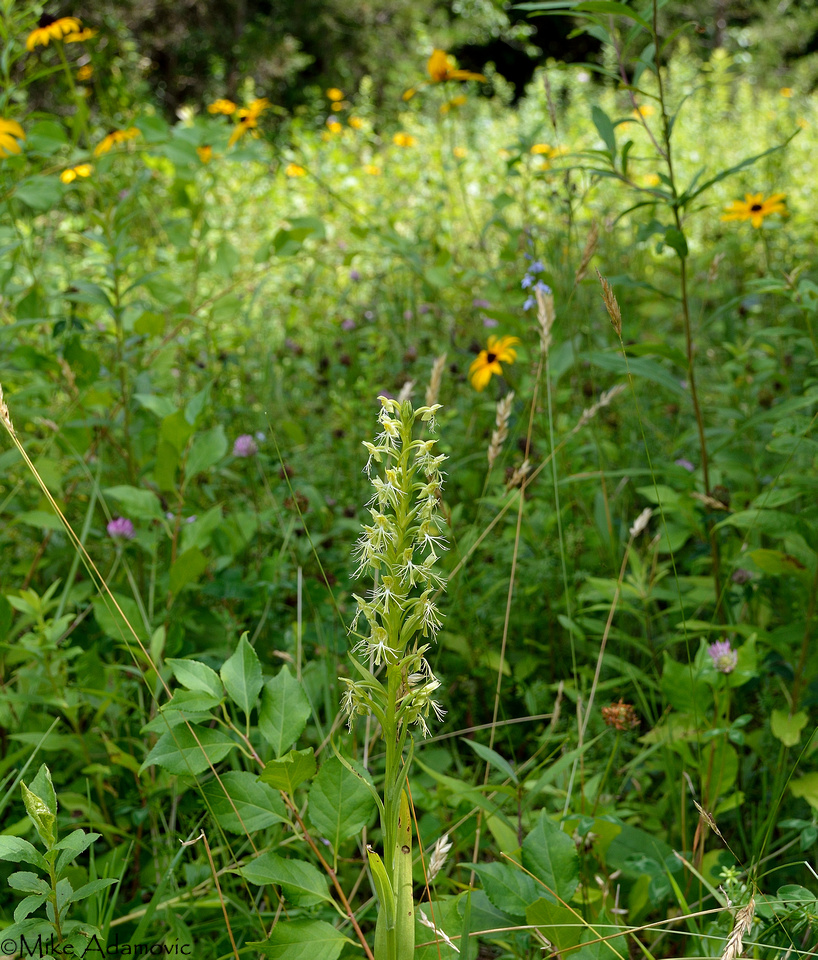

Ragged fringed orchid (Platanthera lacera)


Ragged fringed orchid (Platanthera lacera)
Forest swales and streamsides are lined with yellow lady’s slippers, purple fringed and club-spur orchids.
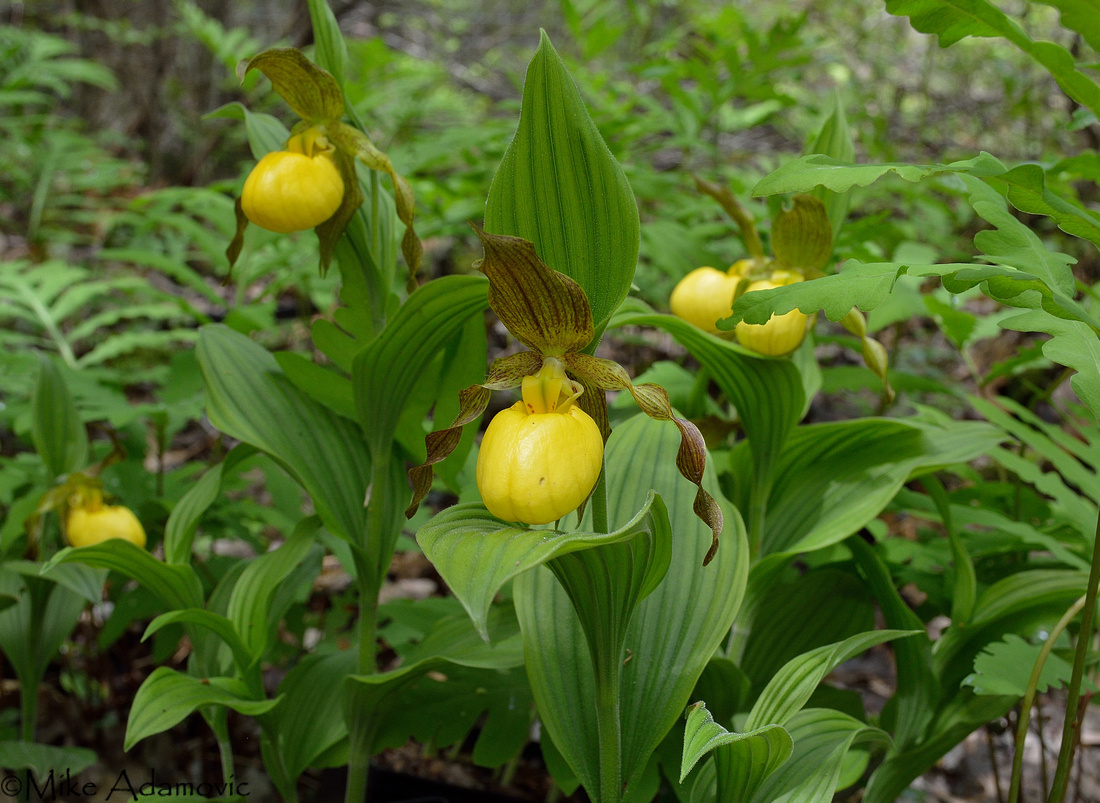

Large yellow lady's slipper (Cypripedium parviflorum var. pubescens)
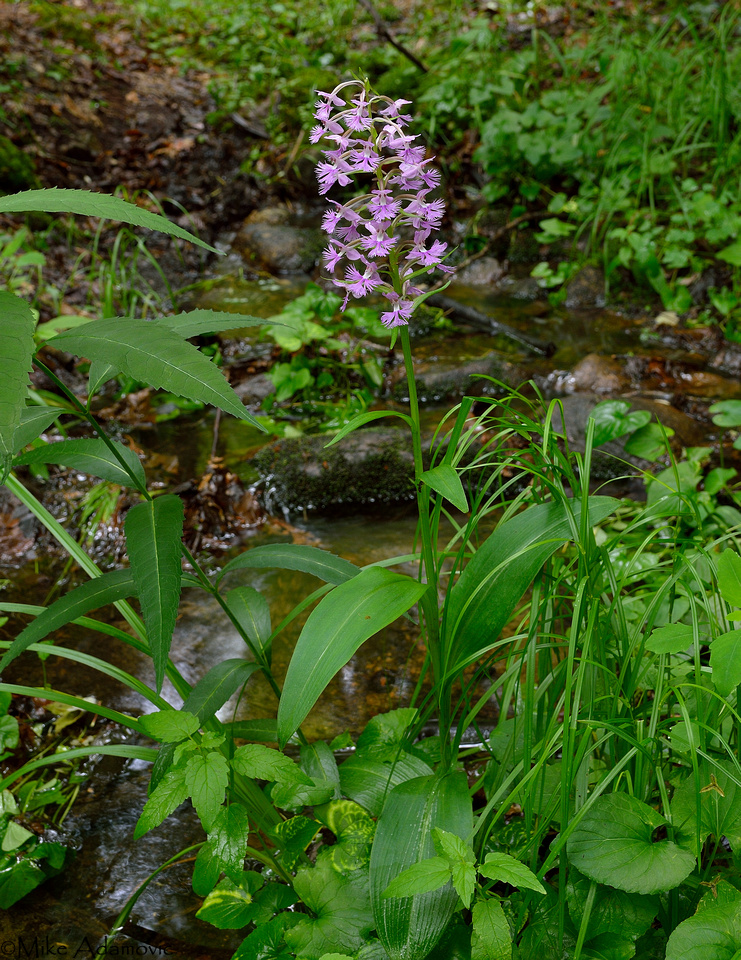

Large purple fringed orchid (Platanthera grandiflora)
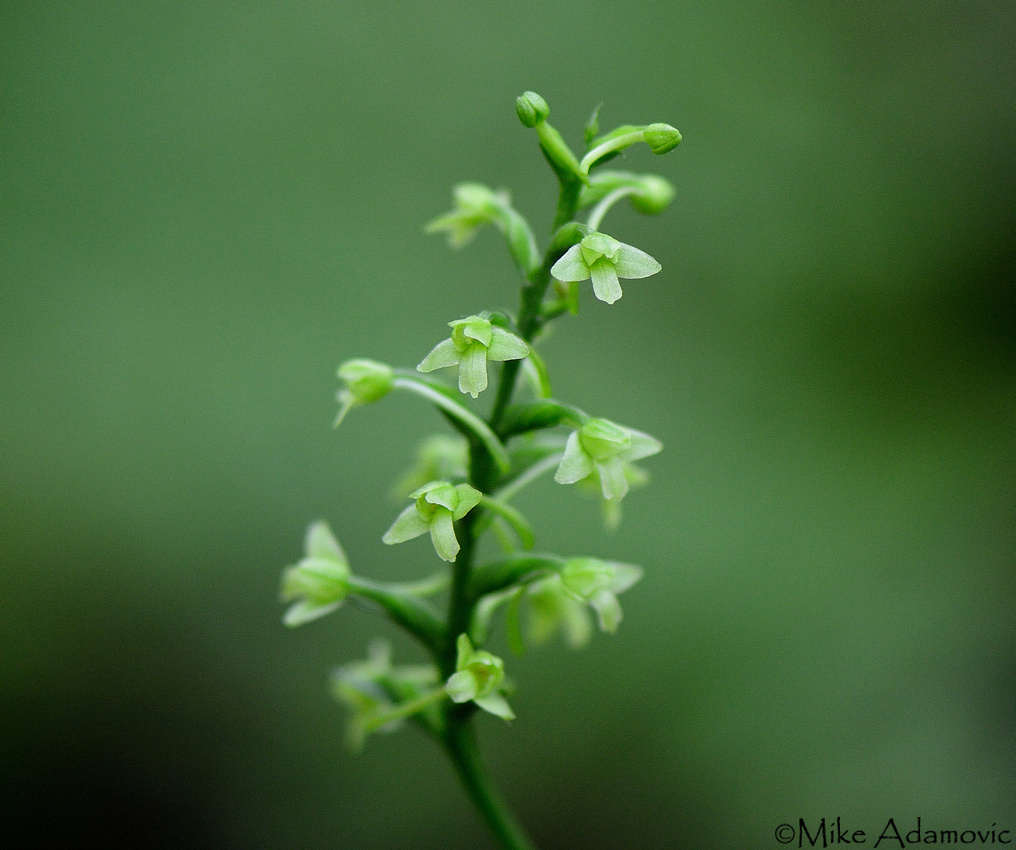

Little club-spur orchid (Platanthera clavellata)
Forest floors with acidic soils may find themselves dotted with pink lady’s slippers, rattlesnake plantains, roundleaved orchids, parasitic coralroots, and large and small whorled pogonias.
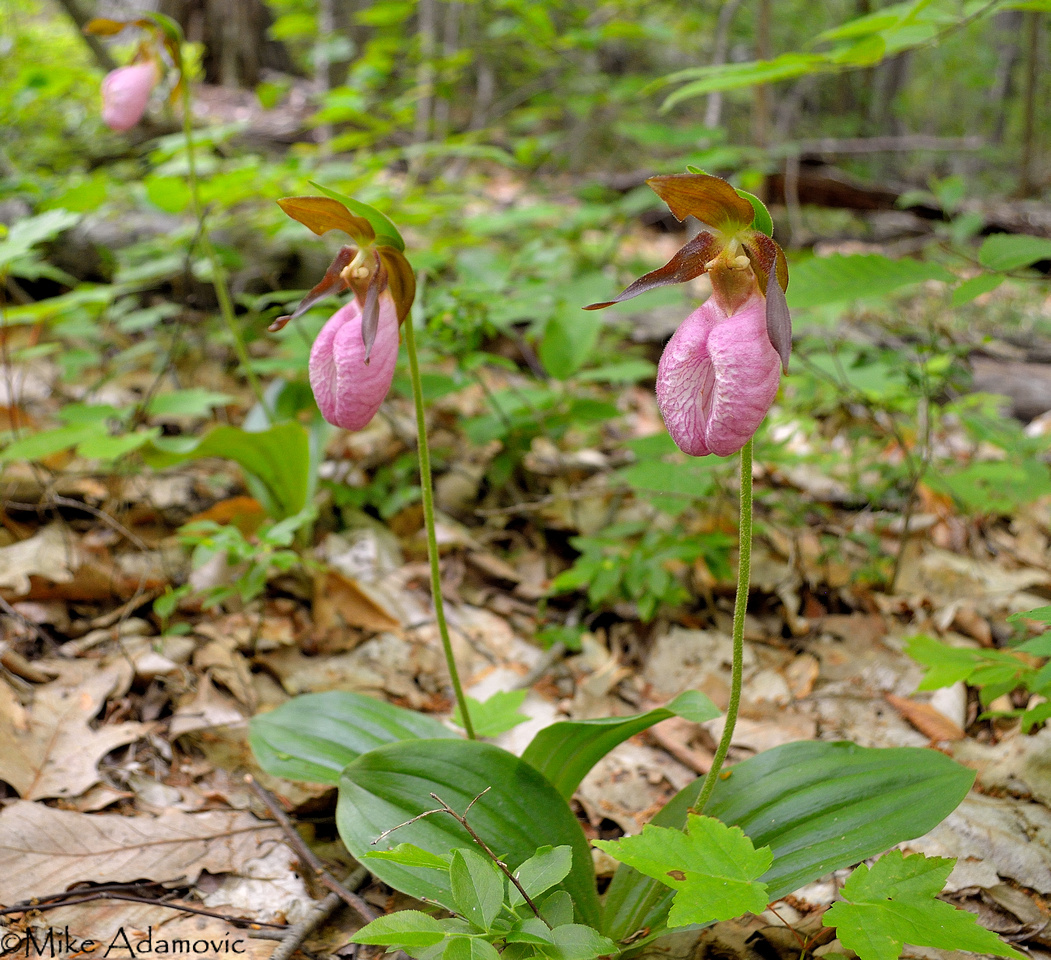
 Pink lady's slipper (Cypripedium acule)
Pink lady's slipper (Cypripedium acule)
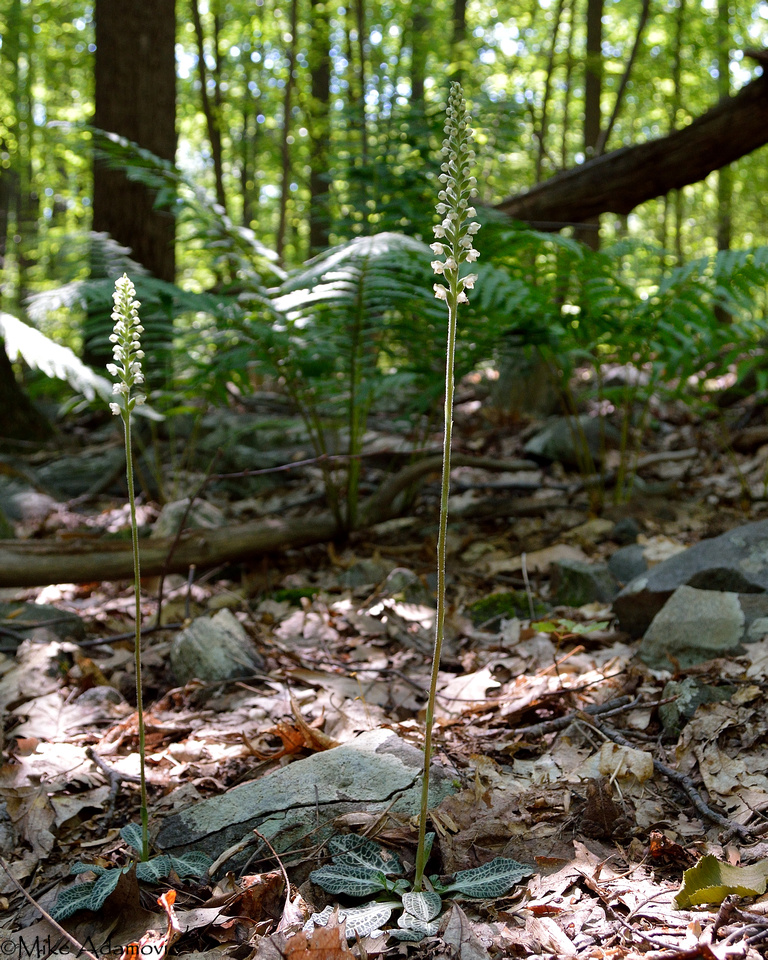

Downy rattlesnake plantain (Goodyera pubescens)


Downy rattlesnake plantain (Goodyera pubescens)


Small whorled pogonia (Isotria medeoloides)
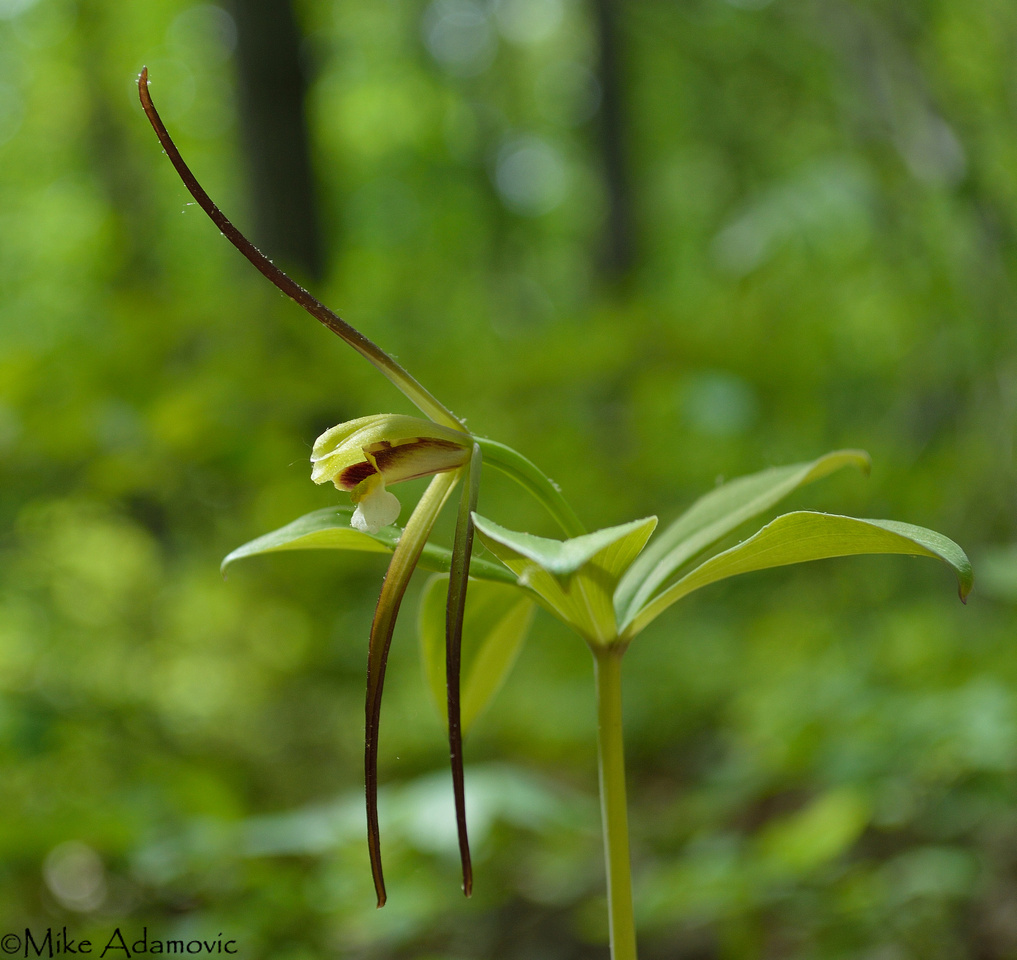

Large whorled pogonia (Isotria verticillata)
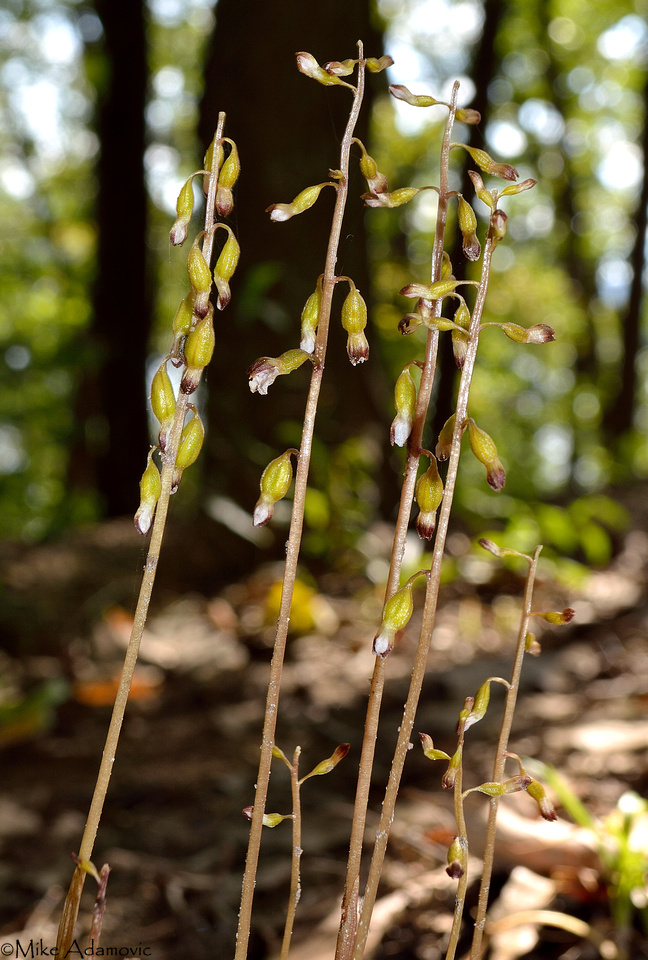

Autumn coralroot (Corallorhiza odontorhiza)
When it comes to the roundleaved orchids, there are two types: the greater (Platanthera macrophylla) and (P. orbiculata) lesser. The greater has marginally more robust leaves and flowers. The main distinguishing characteristic between the two comes down to the size of the nectar spur. The lesser roundleaved orchid possesses spurs that are 26 mm or less in length; its close relative’s ranges from 28-46 mm. It is speculated that differing spur lengths have come about from the availability of pollinators. Both species are pollinated by long-tongued hawk moths. However, the most effective pollinator for the greater roundleaved appears to be the wild cherry sphinx moth, which happens to be larger (and has a longer tongue) than the typical moths that visit the lesser roundleaved.
The greater roundleaved orchid has a narrower range, calling only the Northeast home, whereas the lesser roundleaved orchid spans from New England to Minnesota and south to North Carolina. There is ongoing debate among botanists as to whether the two are merely varieties of one species, the more common P. orbiculata. I tend to be a splitter, rather than a lumper, and recognize them as distinct species. Whatever your feeling on the matter, measuring the spurs of one out in the woods will make you appreciate the rich diversity of life in all its many shapes and forms.
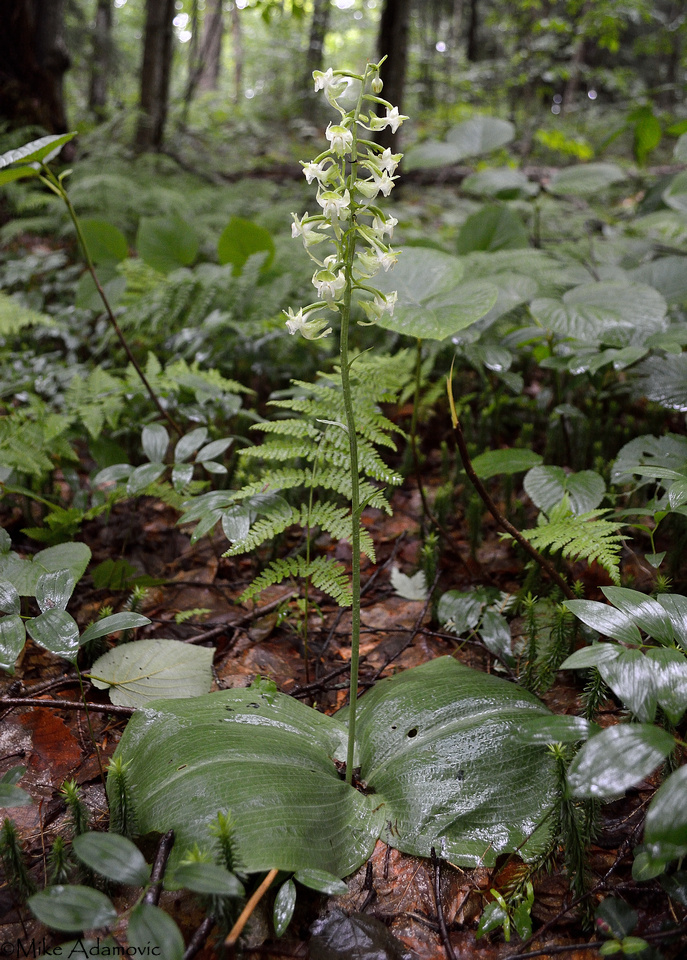

Greater roundleaved orchid (Platanthera macrophylla)
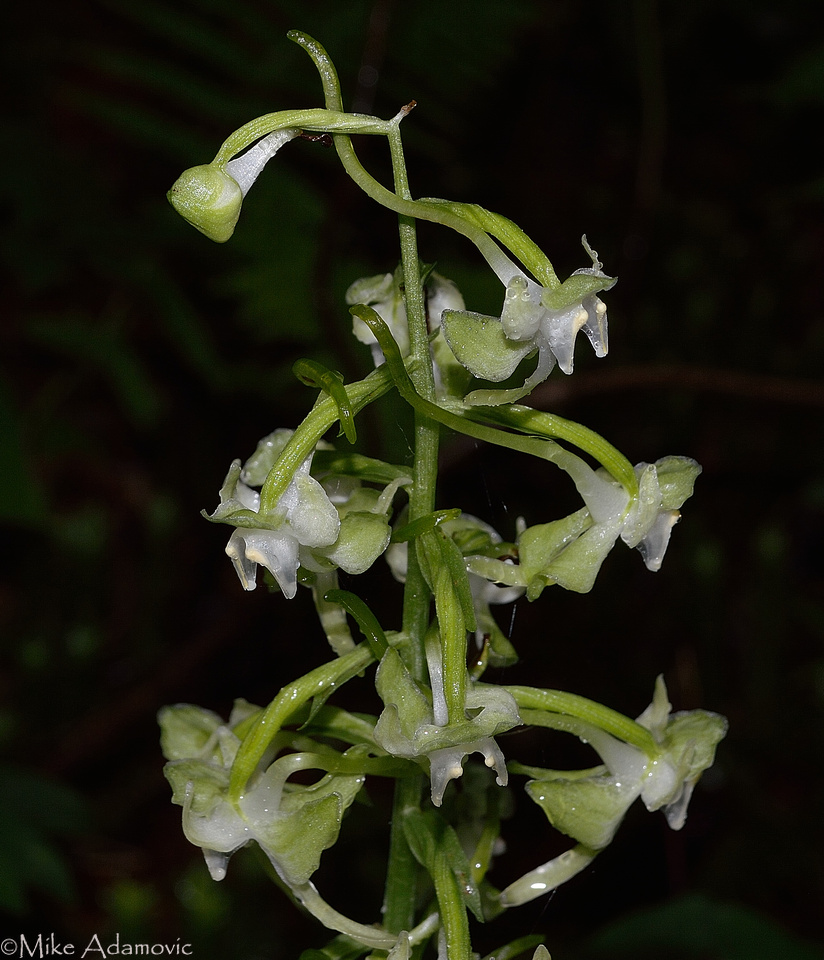

Greater roundleaved orchid (Platanthera macrophylla)
Comments
http://www.bluenightgirls.com/barrackpore-escorts.html
http://www.bluenightgirls.com/behala-escorts.html
http://www.bluenightgirls.com/belgachia-escorts.html
http://www.bluenightgirls.com/bidhan-nagar-escorts.html
http://www.bluenightgirls.com/chetla-escorts.html
http://www.bluenightgirls.com/chinar-park-escorts.html
http://www.bluenightgirls.com/dum-dum-escorts.html
http://www.bluenightgirls.com/siliguri-escorts.html
http://www.bluenightgirls.com/kalyani-escorts.html
http://www.bluenightgirls.com/new-alipore-escorts.html
http://www.bluenightgirls.com/rajarhat-escorts.html
http://www.bluenightgirls.com/sealdah-escorts.html
http://www.bluenightgirls.com/darjeeling-escorts.html
http://www.bluenightgirls.com/kolkata-russian-escorts.html
http://www.bluenightgirls.com/kolkata-housewife-escorts.html
http://www.bluenightgirls.com/kolkata-hotel-escorts.html
http://www.bluenightgirls.com/ultadanga-escorts.html
http://www.bluenightgirls.com/ruby-escorts.html
http://www.bluenightgirls.com/lake-town-escorts.html
http://www.bluenightgirls.com/belghoria-escorts.html
http://www.bluenightgirls.com/budge-budge-escorts.html
http://www.bluenightgirls.com/baguiati-escorts.html
http://www.bluenightgirls.com/tagore-park-escorts.html
http://www.bluenightgirls.com/baruipur-escorts.html
http://www.bluenightgirls.com/science-city-escorts.html
http://www.bluenightgirls.com/howrah-call-girls-escorts.html
http://www.bluenightgirls.com/kolkata-call-girls.html
http://www.bluenightgirls.com/air-hostess-escorts.html
http://www.bluenightgirls.com/bara-bazar-escorts.html
http://www.bluenightgirls.com/beliaghata-escorts.html
http://www.bluenightgirls.com/sonagachi-escorts.html
http://www.bluenightgirls.com/college-call-girls.html
http://www.bluenightgirls.com/salt-lake-escorts.html
http://www.bluenightgirls.com/newtown-escorts.html
http://www.bluenightgirls.com/park-steet-escorts.html
http://www.bluenightgirls.com/dharmatala-escorts.html
http://www.bluenightgirls.com/airport-escorts.html
http://www.bluenightgirls.com/ballygunge-escorts.html
http://www.bluenightgirls.com/jadavpur-escorts.html
http://www.bluenightgirls.com/em-bypass-escorts.html
http://www.bluenightgirls.com/vedic-village-escorts.html
http://www.bluenightgirls.com/shapoorji-escorts.html
http://www.bluenightgirls.com/asansol-escorts.html
http://www.bluenightgirls.com/durgapur-escorts.html
http://www.bluenightgirls.com/bansdroni-escorts.html
http://www.bluenightgirls.com/bengali-call-girls.html
http://www.bluenightgirls.com/chinese-escorts.html
http://www.ankitatiwari.in/siliguri-escort-service-call-girls.html
http://www.ankitatiwari.in/mumbai-escorts.html
http://www.ankitatiwari.in/vedic-village.html
http://www.ankitatiwari.in/saltlake-call-girls.html
http://www.ankitatiwari.in/parksteet-escort.html
http://www.ankitatiwari.in/saporrji-female-escorts.html
http://www.ankitatiwari.in/dharmatala-female.html
http://www.ankitatiwari.in/newtown-escorts.html
http://www.ankitatiwari.in/airportescorts.html
http://www.ankitatiwari.in/ballygunge-models.html
http://www.ankitatiwari.in/jadavpur-independence-escorts.html
http://www.ankitatiwari.in/em-bypass-call-girls.html
http://www.ankitatiwari.in/saporrji-female-escorts.html
http://www.ankitatiwari.in/asansol-escort-call-girls-escort-service.html
http://www.ankitatiwari.in/durgapur-escort-service-call-girls-service.html
http://www.ankitatiwari.in/bansdroni-escort-call-girls-escort-service-bansdroni.html
http://www.ankitatiwari.in/barrackpore-escort-call-girls-in-barrackpore.html
http://www.ankitatiwari.in/behala-call-girls-escort-service.html
http://www.ankitatiwari.in/belgachia-call-girls-escort-service-in-belgachia.html
http://www.ankitatiwari.in/bidhan-nagar-escort-call-girls-in-bidhan-nagar.html
http://www.ankitatiwari.in/chetla-escorts-call-girls.html
http://www.ankitatiwari.in/chinar-park-escort-service-call-girls.html
http://www.ankitatiwari.in/dumdum-escort-call-girls-in-dumdum.html
http://www.ankitatiwari.in/siliguri-escort-service-call-girls.html
http://www.ankitatiwari.in/kalyani-call-girls-escort-service.html
http://www.ankitatiwari.in/new-alipore-escort-call-girls-escorts-service.html
http://www.ankitatiwari.in/rajarhat-escort-service-call-girl-.html
http://www.ankitatiwari.in/escort-service-call-girl-sealdha-escorts.html
http://www.ankitatiwari.in/darjeeling-escort-service-call-girl-escorts.html
http://www.ankitatiwari.in/kolkata-russian-escorts-russian-call-girls.html
http://www.ankitatiwari.in/kolkata-housewife-escorts-belgali-housewife-call-girls.html
http://www.ankitatiwari.in/kolkata-hotel-escort-service.html
http://www.ankitatiwari.in/bengali-call-girls-in-kolkata.html
http://www.ankitatiwari.in/ultadanga-escorts-female-call-girls-in-ultadanga.html
http://www.ankitatiwari.in/ruby-call-girls-escort-ersvice.html
http://www.ankitatiwari.in/lake-town-call-girls-escorts-service.html
http://www.ankitatiwari.in/belghoria-call-girls-escort-service.html
http://www.ankitatiwari.in/budge-budge-call-girls-escorts-service.html
http://www.ankitatiwari.in/baguiati-call-girls-escort-service.html
http://www.ankitatiwari.in/tagore-park-call-girls-escort-service.html
http://www.ankitatiwari.in/baruipur-call-girls-escort-service.html
http://www.ankitatiwari.in/science-city-call-girls-escort-service.html
http://www.ankitatiwari.in/incall-escort-call-girls-escort-service.html
http://www.ankitatiwari.in/outcall-escorts-call-girls-escort-service.html
http://www.ankitatiwari.in/air-hostess-call-girls-escort-service.html
http://www.ankitatiwari.in/barabazar-escorts-call-girls.html
http://www.ankitatiwari.in/beliaghata-call-girls-escort-service-beliaghata.html
http://www.ankitatiwari.in/sonagachi-call-girls-escort-service.html
http://www.ankitatiwari.in/kolkata-college-call-girls-escort-service.html
http://www.piyasen.com/bengali-bhabhi-call-girls.html
http://www.piyasen.com/tollygunge-escorts.html
http://www.piyasen.com/bollywood-escorts-in-kolkata.html
http://www.piyasen.com/indian-escorts-models.html
http://www.piyasen.com/spanish-escort-models.html
http://www.piyasen.com/digha-escorts.html
http://www.piyasen.com/cossipore-escorts-service.html
http://www.piyasen.com/jhargram-escort-service.html
http://www.piyasen.com/kalighat-call-girls.html
http://www.piyasen.com/garia-call-girl.html
http://www.piyasen.com/girish-park-call-girls.html
http://www.piyasen.com/sodhpur-escorts.html
http://www.piyasen.com/gachtala-escorts-service.html
http://www.piyasen.com/beck-bagan-escort-service.html
http://www.piyasen.com/esplanade-escorts.html
http://www.piyasen.com/jatin-das-park-escort.html
http://www.piyasen.com/kankurgachi-escort.html
http://www.piyasen.com/minto-park-escort.html
http://www.piyasen.com/high-class-models-escorts.html
http://www.piyasen.com/dating-models-escorts.html
http://www.piyasen.com/busty-escorts-in-kolkata.html
http://www.piyasen.com/escorts-profile.html
http://www.piyasen.com/low-cost-escort-services.html
http://www.piyasen.com/millennium-park-escorts-service.html
http://www.piyasen.com/kasba-escorts.html
http://www.piyasen.com/chandni-chowk-escort.html
http://www.piyasen.com/prinsep-ghat-escorts.html
http://www.piyasen.com/baranagar-escorts-service.html
http://www.piyasen.com/baghajatin-escort-service.html
http://www.piyasen.com/shobha-bazar-escorts.html
http://www.piyasen.com/bardhaman-escorts.html
http://www.piyasen.com/hooghly-call-girl-escorts.html
http://www.piyasen.com/titagarh-escorts-service.html
http://www.piyasen.com/kavi-nazrul-escorts.html
http://www.piyasen.com/rabindra-sadan-escort.html
http://www.piyasen.com/nakhoda-mosque-escorts.html
http://www.piyasen.com/babughat-escorts.html
http://www.piyasen.com/raja-bazar-sscorts-service.html
http://www.piyasen.com/barrackpore-escort-service.html
http://www.piyasen.com/maheshtala-escorts-service.html
http://www.piyasen.com/adult-dating-swingers.html
http://www.piyasen.com/rajarhat-escorts.html
http://www.piyasen.com/sealdah-escorts.htm
http://www.piyasen.com/darjeeling-escorts.html
http://www.piyasen.com/salt-lake-escort.html
http://www.piyasen.com/newtown-escorts.html
http://www.piyasen.com/park-street-escorts.html
http://www.piyasen.com/dharmatala-escorts.html
http://www.piyasen.com/airport-escorts.html
http://www.piyasen.com/bullygunge-escorts.html
http://www.piyasen.com/jadavpur-escorts.html
http://www.piyasen.com/em-bypass-escorts.html
http://www.piyasen.com/vedic-village.html
http://www.piyasen.com/shapoorji-escorts.html
http://www.piyasen.com/asansol-escorts.html
http://www.piyasen.com/durgapur-sscorts.html
http://www.piyasen.com/bansdroni-escorts.html
http://www.piyasen.com/behala-escorts.html
http://www.piyasen.com/belgachia-escorts.html
http://www.piyasen.com/bidhan-nagar-escorts.html
http://www.piyasen.com/chetla-escorts.html
http://www.piyasen.com/chinar-park-escorts.html
http://www.piyasen.com/dumdum-escorts.html
http://www.piyasen.com/siliguri-escorts.html
http://www.piyasen.com/kalyani-escorts.html
http://www.piyasen.com/new-alipore-escorts.html
http://www.piyasen.com/kolkata-russian-escorts.html
http://www.piyasen.com/kolkata-housewife-escorts.html
http://www.piyasen.com/kolkata-hotel-escorts.html
http://www.piyasen.com/bangali-call-girls.html
http://www.piyasen.com/ultadanga-escorts.html
http://www.piyasen.com/ruby-escort-service.html
http://www.piyasen.com/lake-town-escorts.html
http://www.piyasen.com/belghoria-escorts.html
http://www.piyasen.com/budge-budge-escorts.html
http://www.piyasen.com/baguiati-escorts.html
http://www.piyasen.com/tagore-park-escorts.html
http://www.piyasen.com/baruipur-escorts.html
http://www.piyasen.com/science-city-escorts.html
http://www.piyasen.com/incall-escort-service.html
http://www.piyasen.com/outcall-escort-service.html
http://www.piyasen.com/kolkata-air-hostess-escorts.html
http://www.piyasen.com/bara-bazar-escorts.html
http://www.piyasen.com/beliaghata-escorts.html
http://www.piyasen.com/sonagachi-escorts.html
http://www.piyasen.com/kolkata-college-call-girls-escorts.html
Other City Link
http://www.piyasen.com/mumba-escorts.html
http://www.piyasen.com/bangalore-escorts.html
http://www.piyasen.com/chennai-escorts.html
http://www.piyasen.com/hyderabad-escorts.html
http://www.piyasen.com/pune-escorts.html
http://www.piyasen.com/goa-escorts.html
http://www.piyasen.com/delhi-escorts.html
http://www.piyasen.com/chandigarh-escorts.html
http://www.piyasen.com/raipur-escorts.html
http://www.piyasen.com/jaipur-escorts.html
http://www.piyasen.com/lucknow-escorts.html
http://www.piyasen.com/ahmedabad-escorts.html
http://www.piyasen.com/gourgaon-escorts.html
http://www.piyasen.com/amritsar-escorts.html
http://www.piyasen.com/Indore-escorts.html
http://www.piyasen.com/Bhopal-escorts.html
http://www.vedikarani.com/escorts-call-girls-goregaon.html
http://www.vedikarani.com/escorts-call-girls-jogeshwari.html
http://www.vedikarani.com/escorts-call-girls-juhu.html
http://www.vedikarani.com/escorts-call-girls-malad.html
http://www.vedikarani.com/escorts-call-girls-borivali.html
http://www.vedikarani.com/escorts-call-girls-kandivali.html
http://www.vedikarani.com/escorts-call-girls-lokhandwala.html
http://www.vedikarani.com/escorts-call-girls-mira-road.html
http://www.vedikarani.com/escorts-call-girls-nariman-point.html
http://www.vedikarani.com/escorts-call-girls-powai.html
http://www.vedikarani.com/escorts-call-girls-santacruz.html
http://www.vedikarani.com/escorts-call-girls-vashi.html
http://www.vedikarani.com/escorts-call-girls-versova.html
http://www.vedikarani.com/escorts-call-girls-sakinaka.html
http://www.vedikarani.com/escorts-call-girls-ghatkopar.html
http://www.vedikarani.com/escorts-call-girls-thane.html
http://www.vedikarani.com/escorts-call-girls-vile-parle.html
http://www.vedikarani.com/airport-escort-girls-mumbai.html
http://www.vedikarani.com/vip-escorts-call-girls-in-mumbai.html
http://www.vedikarani.com/mumbai-model-escorts-girls.html
http://www.vedikarani.com/air-hostess-escorts-girl-mumbai.html
http://www.vedikarani.com/housewife-escorts-in-mumbai.html
http://www.vedikarani.com/mumbai-hotel-escorts-girls.html
http://www.vedikarani.com/call-girls-in-mumbai.html
http://www.vedikarani.com/aunty-escorts-mumbai.html
http://www.vedikarani.com/cheap-escorts-girl-mumbai.html
http://www.vedikarani.com/chinese-escorts-mumbai.html
http://www.vedikarani.com/college-girls-escorts-mumbai.html
http://www.vedikarani.com/european-escorts-mumbai.html
http://www.vedikarani.com/spanish-escorts-mumbai.html
http://www.vedikarani.com/turkish-escorts-mumbai.html
http://www.vedikarani.com/busty-escort.html
http://www.vedikarani.com/travel-escorts-mumbai.html
http://www.vedikarani.com/celebrity-girls.html
http://www.vedikarani.com/navi-mumbai-escorts.html